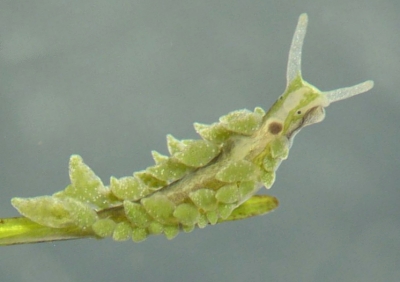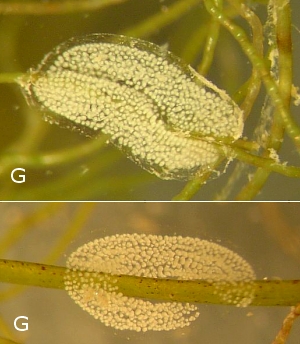Re: Calliopaea bellula - Ercolania cf. viridis & eggs [1]
March 31, 2009
From: M. Poddubetskaia Ossokine

Concerning message #22350:
Dear Bill,
To answer your question about Ercolania viridis eggs, I agree it is different from the photos on the Forum and the best I could do is to produce proof of it in a series of photos.
Before, I'd like to specify that all the Calliopaea and Ercolania photos were taken at my home. The eggs were laid at home too. The algae are from original environment and these animals were found on them. These species were found in a muddy shallow place with approx. 20 cm of visibility (another kind of extreme diving :-) so any photo in situ was completely out of the question.
Here is the first series of photos, those of typical Ercolania viridis:
- Green animal and the related eggs [upper & middle left photos ]: please, note that the egg-mass shape is different from one alga to another.
- Blackish animal and the related eggs [middle right and lower photos]: a black colour form, with eggs completely different from Alex Kurakin's message but similar to that eaten by Calliopaea in my earlier message.
I didn't photograph Ercolania viridis on 9th October (when I photographed Calliopaea bellula ) but they were present and I used their eggs to experience Calliopaea feeding. In a separate message I will send you the animals I'm calling Ercolania cf. viridis with slightly different cerata and egg-ribbons.
Locality: "L'Ecluse de Verdurette", Domaine de Graveyron, Audenge, Bassin d'Arcachon, 1 m, France, Atlantic: Green animal: 25 August 2006, Length: animal 8 mm; eggs 3 and 4 mm. Black animal: 4 September 2006, 6 mm; eggs 5 mm. Photographer: Marina Poddubetskaia .
Best wishes,
Marina.
Nembro website
nembro@yahoo.fr



Dear Marina,
Thanks for this valuable series of photos. So that we can see all the detail, I have split your other photos, which you think may be something slightly different, into a series of separate messages [#22367, #22378, #22379]. What I was querying in my earlier comments was not whether you had correctly matched the eggs to this species, but whether this species is actually Ercolania viridis. As you will have noted from earlier messages on the Forum, the identity of Ercolania viridis has caused some problems which your specimens and their egg ribbons suggest have still not been satisfactorily resolved. As Kathe Jensen discusses, the green Ercolania viridis Costa, 1866 and the black Ercolania funerea Costa 1867 are colour forms of a single species [see message #10165 ].
In your green animal we can see traces of black pigmentation on the sides of the body and both the green and black animals have whitish pustules on the cerata which support your suggestion that they are the same. The egg masses of your animals, however, are so different from those of the earlier ones [messages #8300, #9853] that they must almost certainly be different species. So is your animal Costa's E. viridis or is the one already on the Forum that species?
Hopefully Kathe Jensen can give us some ideas.
Best wishes,
Bill Rudman
Related messages
-
Re: Calliopaea bellula - Ercolania cf. viridis & eggs
From: Marina Poddubetskaia Ossokine, April 6, 2009 -
Re: Calliopaea bellula - Ercolania cf. viridis & eggs
From: Kathe Rose Jensen, April 2, 2009 -
Re: Calliopaea bellula - Ercolania cf viridis & eggs [4]
From: M. Poddubetskaia Ossokine, March 31, 2009 -
Re: Calliopaea bellula - Ercolania cf. viridis & eggs [3]
From: M. Poddubetskaia Ossokine, March 31, 2009 -
Re: Calliopaea bellula - Ercolania cf. viridis & eggs [2]
From: M. Poddubetskaia Ossokine, March 31, 2009
